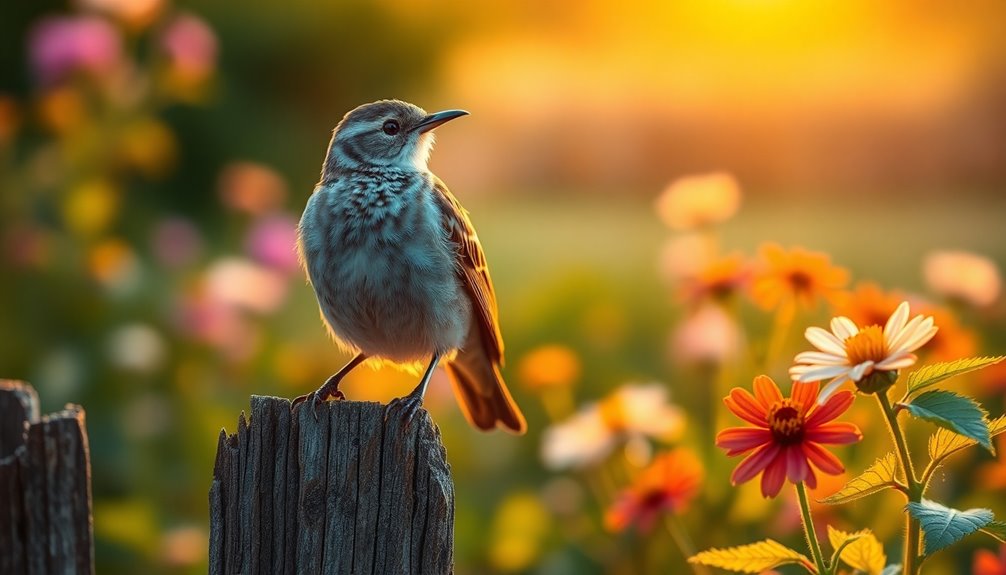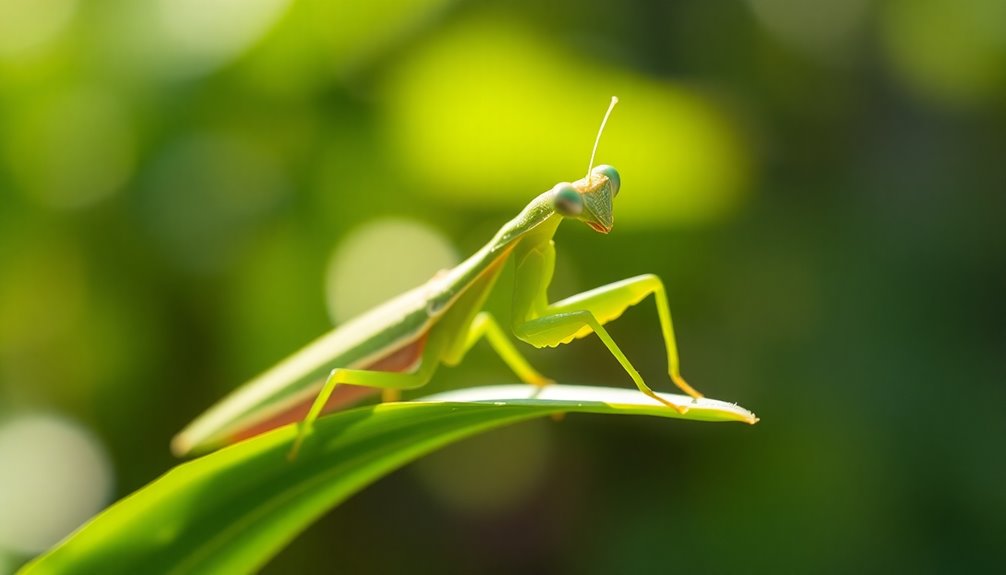The mockingbird symbolizes innocence and the responsibility to protect those who can't protect themselves. Just like in "To Kill a Mockingbird," characters like Tom Robinson and Boo Radley represent this delicate innocence. When someone harms the innocent, it's seen as a serious mistake. You might remember Miss Maudie's words about defending the defenseless. Killing a mockingbird isn't just wrong; it teaches us that we must stand up for others. This powerful symbol encourages empathy and understanding. Each mockingbird reminds us to cherish and protect innocence, inviting you to discover even more about their fascinating lessons.
Key Takeaways
- Mockingbirds symbolize the fragility of innocence and the moral obligation to protect those who cannot defend themselves.
- In literature, they represent characters like Tom Robinson and Boo Radley, who embody vulnerability and the consequences of societal injustice.
- The act of harming a mockingbird is viewed as a grave mistake, reinforcing the duty to safeguard the innocent.
- Culturally, mockingbirds are seen as symbols of communication, creativity, and adaptability across various traditions.
- Their ability to mimic diverse sounds highlights the importance of diverse perspectives and the power of storytelling.
Overview of Mockingbird Symbolism
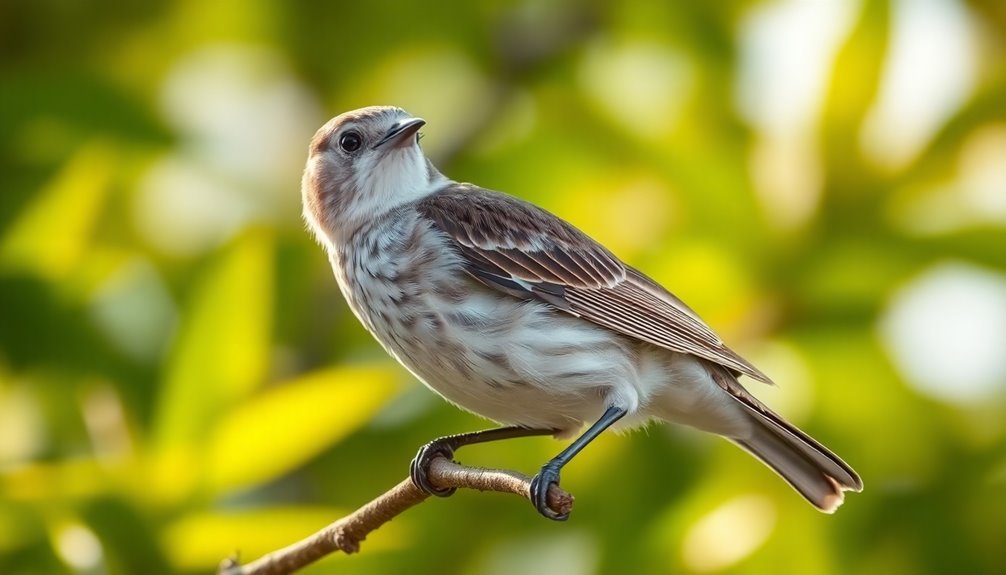
The mockingbird's symbolism in literature often represents the fragility of innocence and the moral imperative to protect those who do no wrong. In Harper Lee's classic novel, "To Kill a Mockingbird," this symbolism shines through in characters like Tom Robinson and Boo Radley. They embody innocence, and their stories remind us that harming the innocent is a grave mistake.
When you read about Tom Robinson's tragic fate, it becomes clear that his death is like killing a mockingbird, a symbol of what we should cherish and defend. Miss Maudie's quote about mockingbirds highlights their harmless nature, teaching us that we must stand up for those who can't protect themselves.
The mockingbird's ability to mimic sounds mirrors our need to understand different viewpoints, making communication essential. This theme encourages you to listen and empathize with others.
In folklore, mockingbirds also symbolize guardianship and creativity, adding more layers to their meaning.
Cultural Significance of Mockingbirds
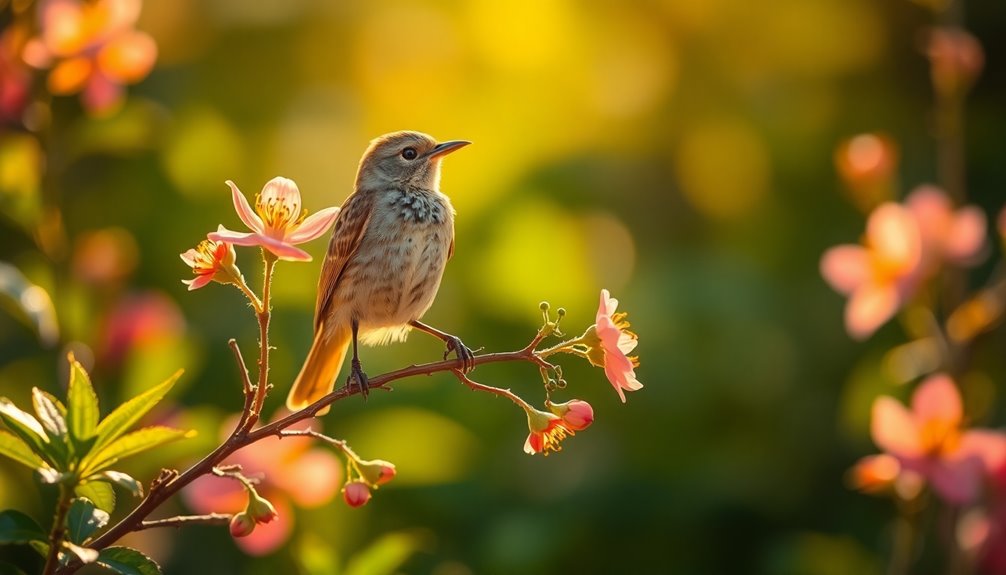
Mockingbirds hold significant cultural value across various societies, extending their symbolism beyond literature. You'll find that different cultures celebrate these birds for unique reasons. They inspire stories, creativity, and transformation. Here's a closer look:
| Culture | Symbolism |
|---|---|
| Indigenous Cultures | Communication and storytelling |
| Southern U.S. | Beauty, resilience, cultural heritage |
| Caribbean Culture | Transformation and renewal |
| Chinese Culture | Happiness and prosperity |
| Australian Aboriginal | Adaptability and survival |
In Indigenous cultures, mockingbirds are seen as intelligent teachers. They help animals communicate and share stories. In the Southern United States, the mockingbird symbolizes beauty and resilience, proudly serving as Mississippi's state bird. Caribbean communities view them as symbols of transformation and renewal, celebrating creativity.
In China, mockingbirds represent happiness and harmony. Meanwhile, in Australian Aboriginal culture, they're known as tricksters, illustrating adaptability in tough times. Overall, mockingbirds symbolize a rich tapestry of meanings, reminding us of the beauty of connection and storytelling across cultures.
Mockingbird Behavior and Traits
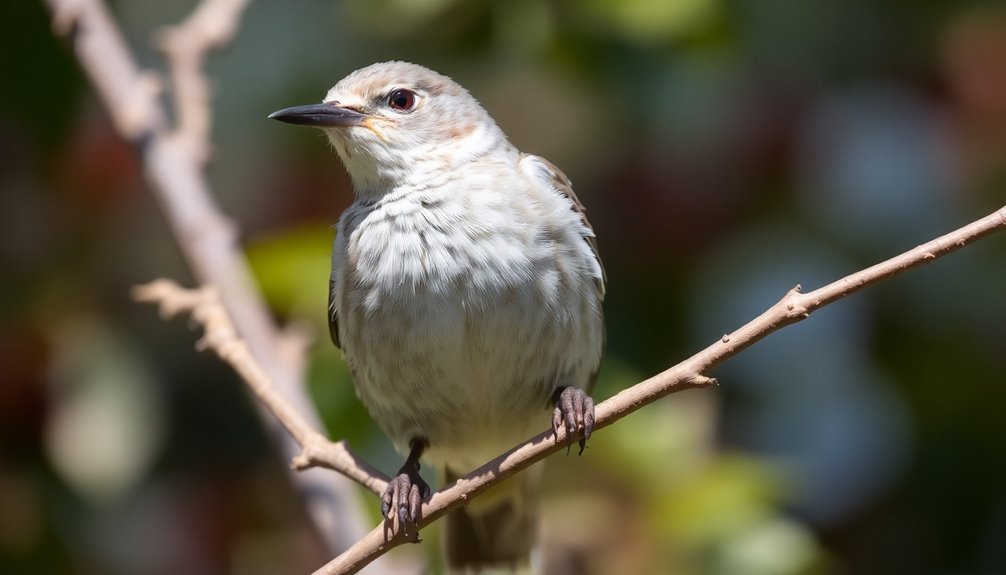
There's something fascinating about how mockingbirds behave and interact with their environment. These clever birds have an impressive ability to mimic sounds, imitating over 200 different species! This talent shows just how adaptable and intelligent they are.
When you watch a mockingbird, you might notice its unique vocal patterns. Males sing longer and louder than females, especially when trying to attract a mate during breeding season.
Mockingbird behavior also includes strong territorial behavior. Male mockingbirds are quite protective of their space. They sing loudly and persistently to announce their presence and defend their territory. If another bird gets too close, you might see some fierce confrontations, even with larger birds! This shows their instinct to protect their nests.
Fun fact: mockingbirds are primarily insect eaters, but they'll also munch on fruit and seeds. This versatility in their diet helps them thrive in various environments.
Mockingbird in Literature

In literature, the mockingbird takes on profound symbolism, particularly in Harper Lee's "To Kill a Mockingbird." This novel uses the bird as a powerful metaphor for innocence and the moral obligation to protect those who do no harm.
You see, characters like Tom Robinson and Boo Radley represent those innocent souls vulnerable to the cruelty of society. Tom's tragic fate highlights how racial injustice can destroy a good person, just like killing a mockingbird is seen as a terrible sin.
Miss Maudie reminds us that mockingbirds embody purity and kindness, urging us to show empathy toward those who are marginalized. When Scout realizes that harming Boo Radley is like killing a mockingbird, it marks a significant moment in her moral growth. She learns the importance of compassion in a world filled with flaws.
The comparison of Tom Robinson's death to Mr. Underwood's metaphorical slaughter of songbirds paints a vivid picture of the senseless loss of innocence.
Through these characters, Harper Lee encourages you to protect the innocent and understand the deeper meanings of kindness and empathy. Isn't it amazing how a simple bird can carry such weight in a story?
The Mockingbird in Folklore
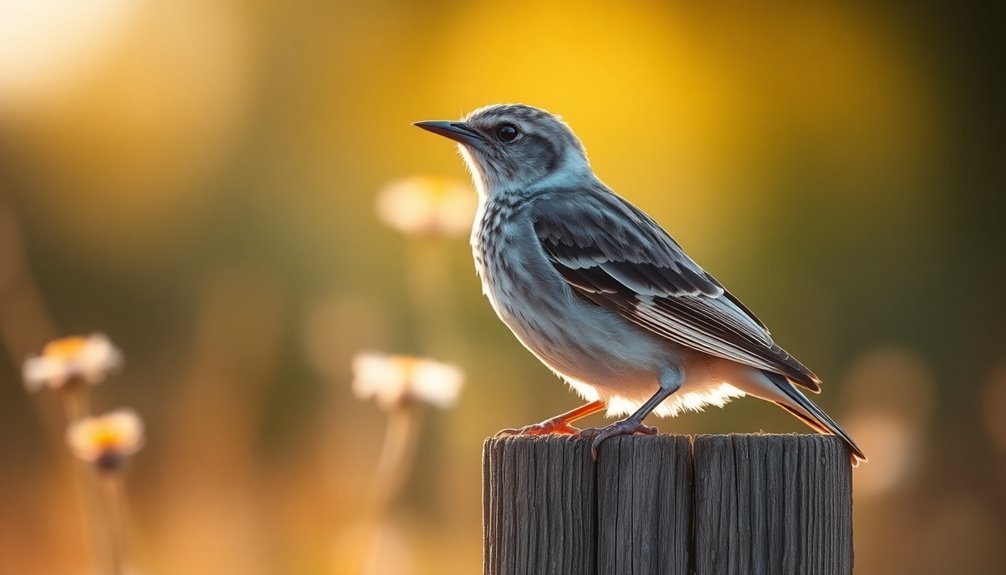
How do different cultures perceive the mockingbird beyond literature? In many places, mockingbirds hold a special place in folklore. For example, in Hopi Katsina ceremonies, these birds are known as Yapa or Yaupa. They're believed to teach people how to speak, which shows just how important communication is to these cultures.
In the Southeastern U.S., some communities see mockingbirds as smart creatures. Their cleverness is so admired that people even eat them! This highlights their wisdom and the value placed on intelligence in these stories.
Moreover, in Oodham folklore, mockingbirds act as mediators during rain ceremonies. They connect the spiritual and natural worlds, showing their significant role in the community.
Across various Indigenous cultures, mockingbirds symbolize protection. They're often seen as guardians over the dead, emphasizing their role in the transmission of knowledge.
With their ability to mimic sounds and create beautiful melodies, mockingbirds have become key figures in storytelling, reflecting local values and beliefs.
Innocence and Protection Themes
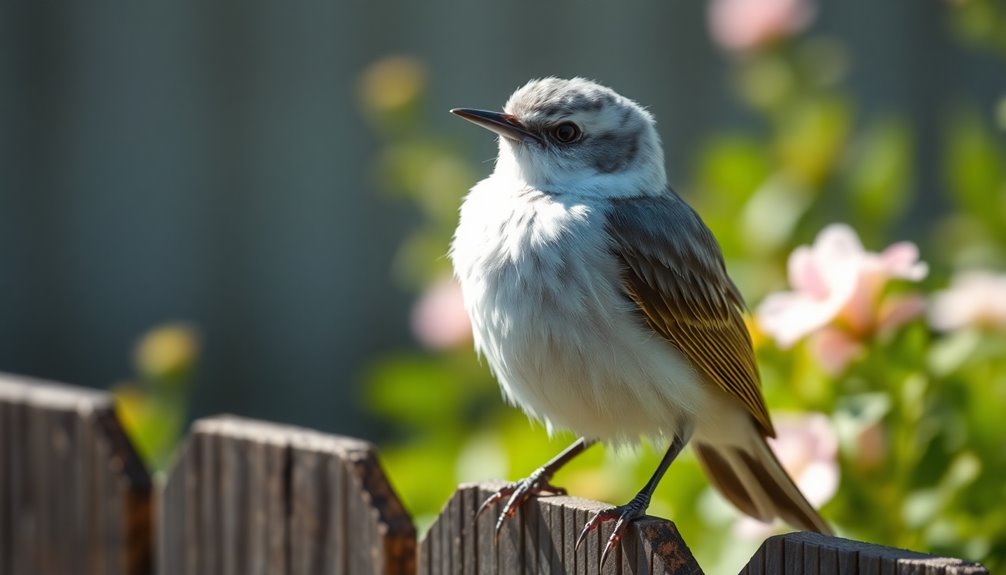
The symbolism of the mockingbird extends into themes of innocence and protection, particularly in literature like "To Kill a Mockingbird." Characters such as Tom Robinson and Boo Radley embody innocence, yet they face harm from societal prejudice. These characters remind us how important it is to protect those who are vulnerable.
| Character | Theme of Innocence and Protection |
|---|---|
| Tom Robinson | Wrongfully accused, he symbolizes the destruction of innocence. |
| Boo Radley | Protects Scout and Jem, showing that innocence can defend others. |
| Atticus Finch | Teaches empathy and moral integrity, urging us to safeguard the innocent. |
In the story, the act of killing a mockingbird is seen as a sin, highlighting our duty to protect innocent beings. Tom's wrongful conviction is a heartbreaking example of how society can harm those who mean no harm. Meanwhile, Boo's protective nature shows that even the shyest individuals can be guardians.
Through these themes, we learn that innocence deserves protection, and we should all endeavor to defend those who can't defend themselves. So, let's take a page from Atticus Finch and practice empathy in our own lives!
Mockingbird as a Creative Muse
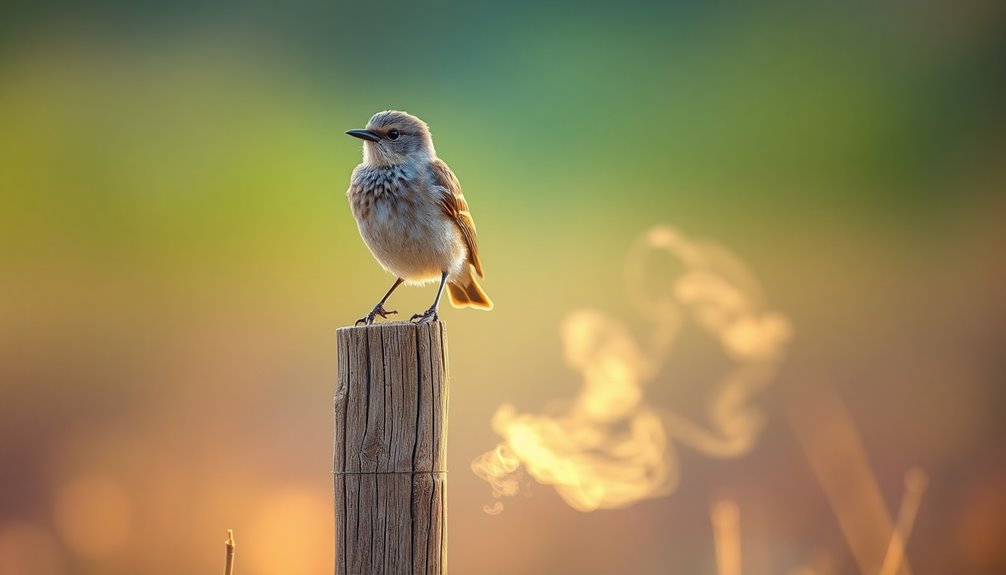
The mockingbird is like a spark for your creativity! Its ability to mimic different sounds shows how inspiration can come from all around you, blending various ideas into something new.
When you embrace these diverse perspectives, you unleash your creative potential and find joy in expressing yourself like never before!
Inspiration for Artistic Expression
With their remarkable ability to mimic a symphony of sounds, mockingbirds serve as a profound source of inspiration for artists seeking to explore and fuse various influences in their creative expressions.
The mockingbird comes to symbolize the importance of blending different styles, encouraging you to discover your unique voice. Their intricate melodies inspire you to experiment with various art forms, highlighting the significance of creativity in personal growth.
Here are a few ways mockingbirds can spark your artistic journey:
- They remind you to balance authenticity with innovation, blending innocence with creativity.
- Their role in storytelling emphasizes the power of sharing experiences across cultures.
- The presence of mockingbirds in literature, like in "To Kill a Mockingbird," prompts reflections on justice and empathy.
As you listen to their songs, let the mockingbird guide your imagination. Their melodies invite you to take risks, try new things, and embrace your artistic side.
Embracing Diverse Perspectives
Countless artists find inspiration in the mockingbird, whose ability to mimic diverse sounds highlights the value of embracing varied perspectives in creative work. This special bird's wide range of songs shows how important it's to explore different styles and forms in your own creativity.
When you listen to a mockingbird, you can hear a mix of melodies that come from various sources, reminding you to be open to all kinds of influences.
The mockingbird's adaptability in different environments teaches you to be flexible and welcoming to new ideas. You can learn so much by collaborating with others, just like the mockingbird combines sounds from its surroundings. This beautiful blend of voices illustrates how powerful collaboration can be, enriching your artistic expression.
Moreover, the mockingbird symbolizes communication, showing that storytelling flourishes when we share our unique experiences and viewpoints.
Unlocking Creative Potential
Revealing your creative potential often feels like discovering a hidden treasure within yourself, and the mockingbird serves as a perfect muse for this journey. This amazing bird can mimic the sounds around it, reminding you of the importance of creativity and adaptability in your own artistic expression. Just like the mockingbird, you can blend different ideas to create something unique.
Here are some ways the mockingbird inspires you:
- Embrace your voice: Authentic self-expression is key. Don't be afraid to share your thoughts and feelings through art.
- Explore possibilities: The mockingbird's melodies show that imagination has no limits. Let your creativity soar in any direction you choose.
- Set boundaries: Just as mockingbirds defend their territory, it's important to assert your creative space. This builds resilience and confidence in your pursuits.
In many cultures, mockingbirds symbolize communication and storytelling. They remind you that your creativity can contribute to cultural expression. Moreover, the mockingbird teaches us that embracing failure is essential for growth, as even the most skilled artists often learn from their missteps along the way.
Personal Reflections on Mockingbirds
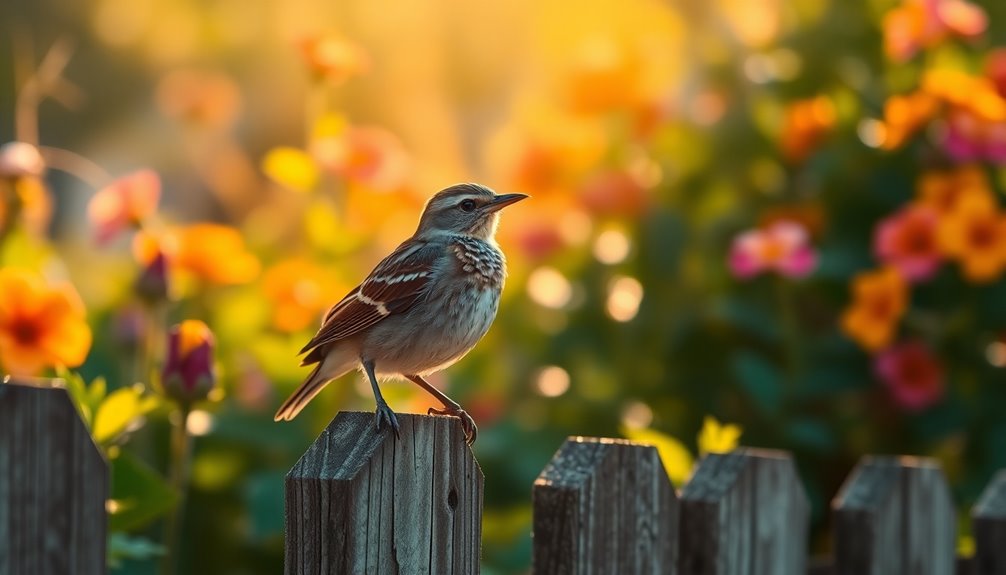
Mockingbirds, with their lively songs and playful antics, often serve as a reminder of the delicate balance between innocence and protection in our lives. When you spot a mockingbird, it can feel like a positive omen, nudging you to reflect on your own experiences. These birds can inspire you to think about how you communicate and express yourself within your communities.
As you listen to their cheerful melodies, it becomes clear how important they're to our local ecosystems. They remind us of the beauty of nature and the importance of protecting it. If you've ever attracted mockingbirds to your garden, you know how rewarding it's to create environments that support local wildlife.
Observing mockingbirds can deepen your connection to nature, making you more aware of the delicate interactions happening all around you. Each chirp and flutter brings joy, encouraging you to cherish and nurture the world we live in.
Lessons From Mockingbird Symbolism
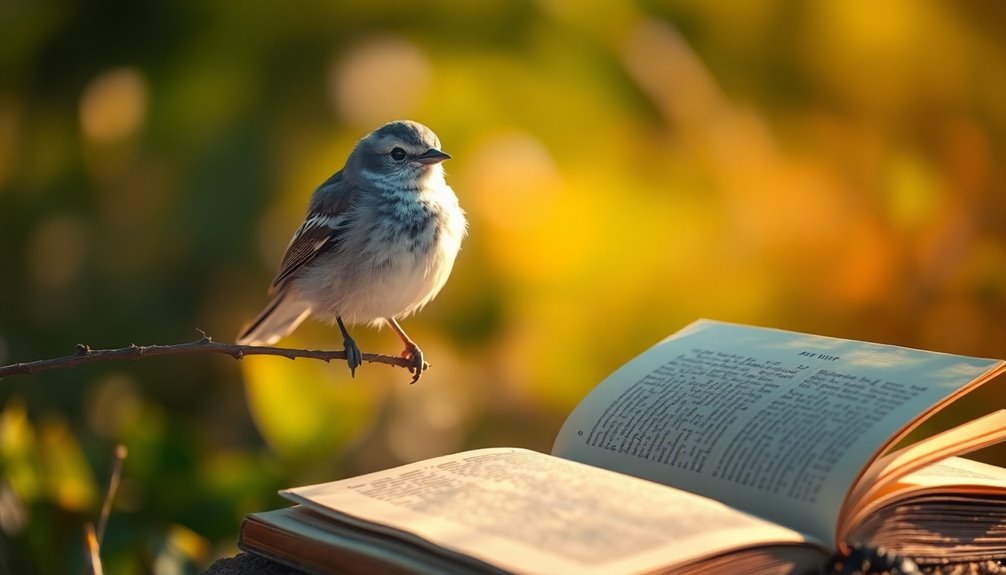
In the domain of literature and life, the symbolism of the mockingbird teaches us invaluable lessons about innocence and the moral obligations we hold toward one another. This beautiful bird represents goodness, and harming it's considered a sin to kill. The stories of Tom Robinson and Boo Radley highlight how society often targets the innocent.
Here are some key lessons from mockingbird symbolism:
- Protecting the innocent is a moral duty.
- Recognizing and standing against injustice helps us grow.
- Everyone deserves compassion and understanding.
When Scout Finch learns it's wrong to harm Boo Radley, she understands the importance of safeguarding those who do no harm.
Similarly, Tom Robinson's wrongful conviction showcases the devastating effects of racism, emphasizing that innocence can be destroyed in the most cruel ways.
Miss Maudie reminds us that we must protect those who are vulnerable.
By reflecting on mockingbird symbolism, you can become a better friend and ally. You'll find joy in kindness and compassion, realizing that every small action counts.
Frequently Asked Questions
What Is the Meaning Behind Mockingbird?
The meaning behind a mockingbird is all about innocence and protection.
These birds are known for their beautiful songs and ability to mimic sounds, which makes them special.
When you think of a mockingbird, imagine a creature that represents goodness and the importance of safeguarding those who do no harm.
Their presence reminds us to cherish the pure things in life and stand up for what we love, creating a joyful connection to nature.
What Is the Myth of the Mockingbird?
Have you ever heard a mockingbird singing in the evening?
In Native American myths, these clever birds are often seen as teachers and messengers. They mimic sounds, showing their intelligence and adaptability.
In some stories, mockingbirds protect spirits and help connect people to nature. They even play important roles in ceremonies, teaching us about communication and understanding.
Why Are Mockingbirds so Special?
Mockingbirds are special because they can mimic the sounds of over 200 different birds and even some human noises! This amazing talent shows how smart and adaptable they are.
You might hear their beautiful songs during spring when they're singing to attract mates. Plus, they thrive in many environments, making them a symbol of freedom and individuality.
Their resilience and charm truly make mockingbirds a beloved part of nature!
What Does a Mockingbird Mean in the Bible?
While mockingbirds aren't directly mentioned in the Bible, they embody many wonderful themes found in biblical stories.
Birds often symbolize freedom and God's care for all creatures. Just like these birds, mockingbirds represent creativity, as they mimic sounds and sing beautifully.
Their songs can remind you of joy and hope, qualities that connect all living things.
Conclusion
To sum up, mockingbirds are more than just beautiful singers; they symbolize innocence, creativity, and protection. Imagine a child listening to a mockingbird's song, feeling safe and inspired. This simple moment can remind us of the joy and beauty in our everyday lives. Whether in stories, songs, or our own experiences, mockingbirds teach us valuable lessons. So next time you hear one, take a moment to appreciate its message and the joy it brings!

